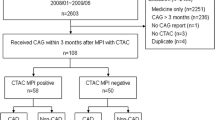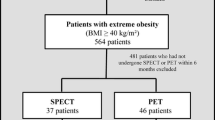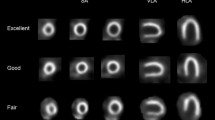Abstract
Background
The diagnostic value of gated myocardial perfusion single-photon emission computed tomography (MPS) with combined supine and prone acquisitions to detect coronary artery disease (CAD) in obese and nonobese patients has not been defined.
Methods and Results
We studied 1511 patients without prior myocardial infarction or coronary revascularization who either had coronary angiography within 3 months of MPS (n = 785) or had a low pretest likelihood of CAD (n = 726). All patients underwent rest thallium 201/gated exercise or adenosine stress technetium 99m sestamibi MPS in both the supine and prone positions. According to body mass index (BMI), patients were categorized as normal weight (BMI of 18.5-24.9 kg/m2), overweight (BMI of 25.0-29.9 kg/m2), or obese (BMI >30.0 kg/m2). There were no significant differences in stress, fixed, or ischemic defects among patients in different weight categories. The sensitivity of MPS was 85%, 86%, and 89% for detecting patients with 50% or greater coronary stenosis and 89%, 91%, and 92% for detecting those with 70% or greater coronary stenosis in the normal-weight, overweight, and obese groups, respectively. Normalcy rates were nearly identical among the 3 weight groups (99%, 98%, and 99%, respectively). Multivariate logistic regression analysis further confirmed that BMI was a nonsignificant predictor for the detection of CAD. In a subset of 290 patients, automated quantitative MPS analysis confirmed that combined supine and prone MPS increased specificity (86%) in identifying CAD, without a significant reduction in sensitivity (83% for >50% stenosis and 88% for >70% stenosis).
Conclusion
The findings of this study suggest that MPS performed with gating and combined supine and prone acquisitions without attenuation correction had a similar diagnostic accuracy for the detection of CAD in normal-weight, overweight, and obese patients.
Similar content being viewed by others
References
Mokdad AH, Ford ES, Bowman BA, Dietz WH, Vinicor F, Bales VS, et al. Prevalence of obesity, diabetes, and obesity-related health risk factors, 2001. JAMA 2003;289:76–9.
Ficaro EP, Fessler JA, Shreve PD, Kritzman JN, Rose PA, Corbett JR. Simultaneous transmission/emission myocardial perfusion tomography. Diagnostic accuracy of attenuation-corrected 99mTcsestamibi single-photon emission computed tomography. Circulation 1996;93:463–73.
Hansen CL, Woodhouse S, Kramer M. Effect of patient obesity on the accuracy of thallium-201 myocardial perfusion imaging. Am J Cardiol 2000;85:749–52.
Taillefer R, DePuey EG, Udelson JE, Beller GA, Latour Y, Reeves F. Comparative diagnostic accuracy of Tl-201 and Tc-99m sestamibi SPECT imaging (perfusion and ECG-gated SPECT) in detecting coronary artery disease in women. J Am Coll Cardiol 1997;29:69–77.
Hendel RC, Corbett JR, Cullom SJ, DePuey EG, Garcia EV, Bateman TM. The value and practice of attenuation correction for myocardial perfusion SPECT imaging: a joint position statement from the American Society of Nuclear Cardiology and the Society of Nuclear Medicine. J Nucl Cardiol 2002;9:135–43.
Hendel RC, Berman DS, Cullom SJ, Follansbee W, Heller GV, Kiat H, et al. Multicenter clinical trial to evaluate the efficacy of correction for photon attenuation and scatter in SPECT myocardial perfusion imaging. Circulation 1999;99:2742–9.
Thompson RC, Heller GV, Johnson LL, Case JA, Cullom SJ, Garcia EV, et al. Value of attenuation correction on ECG-gated SPECT myocardial perfusion imaging related to body mass index. J Nucl Cardiol 2005;12:195–202.
Grossman GB, Garcia EV, Bateman TM, Heller GV, Johnson LL, Folks RD, et al. Quantitative Tc-99m sestamibi attenuationcorrected SPECT: development and multicenter trial validation of myocardial perfusion stress gender-independent normal database in an obese population. J Nucl Cardiol 2004;11:263–72.
Segall GM, Davis MJ, Goris ML. Improved specificity of prone versus supine thallium SPECT imaging. Clin Nucl Med 1988;13:915–66.
Esquerre JP, Coca FJ, Martinez SJ, Guiraud RF. Prone decubitus: a solution to inferior wall attenuation in thallium-201 myocardial tomography. J Nucl Med 1989;30:398–401.
Kiat H, Van Train KF, Friedman JD, Germano G, Silagan G, Wang FP, et al. Quantitative stress-redistribution thallium-201 SPECT using prone imaging: methodologic development and validation. J Nucl Med 1992;33:1509–15.
Segall GM, Davis MJ. Prone versus supine thallium myocardial SPECT: a method to decrease artifactual inferior wall defects. J Nucl Med 1989;30:548–55.
Perault C, Loboguerrero A, Liehn JC, Wampach H, Gibold C, Ouzan J, et al. Quantitative comparison of prone and supine myocardial SPECT MIBI images. Clin Nucl Med 1995;20:678–84.
Hayes SW, De Lorenzo A, Hachamovitch R, Dhar SC, Hsu P, Cohen I, et al. Prognostic implications of combined prone and supine acquisitions in patients with equivocal or abnormal supine myocardial perfusion SPECT. J Nucl Med 2003;44:1633–40.
Lima RS, Watson DD, Goode AR, Siadaty MS, Ragosta M, Beller GA, et al. Incremental value of combined perfusion and function over perfusion alone by gated SPECT myocardial perfusion imaging for detection of severe three-vessel coronary artery disease. J Am Coll Cardiol 2003;42:64–70.
Smanio PE, Watson DD, Segalla DL, Vinson EL, Smith WH, Beller GA. Value of gating of technetium-99m sestamibi singlephoton emission computed tomographic imaging. J Am Coll Cardiol 1997;30:1687–92.
Diamond GA, Staniloff HM, Forrester JS, Pollock BH, Swan HJ. Computer-assisted diagnosis in the noninvasive evaluation of patients with suspected coronary artery disease. J Am Coll Cardiol 1983;1:444–55.
Peeters A, Barendregt JJ, Willekens F, Mackenbach JP, Al Mamun A, Bonneux L. Obesity in adulthood and its consequences for life expectancy: a life-table analysis. Ann Intern Med 2003;138:24–32.
Kenchaiah S, Evans JC, Levy D, Wilson PW, Benjamin EJ, Larson MG, et al. Obesity and the risk of heart failure. N Engl J Med 2002;347:305–13.
Berman DS, Kiat H, Friedman JD, Wang FP, van Train K, Matzer L, et al. Separate acquisition rest thallium-201/stress technetium- 99m sestamibi dual-isotope myocardial perfusion single-photon emission computed tomography: a clinical validation study. J Am Coll Cardiol 1993;22:1455–64.
Berman DS, Kang X, Hayes SW, Friedman JD, Cohen I, Abidov A, et al. Adenosine myocardial perfusion single-photon emission computed tomography in women compared with men. Impact of diabetes mellitus on incremental prognostic value and effect on patient management. J Am Coll Cardiol 2003;41:1125–33.
Germano G, Kiat H, Kavanagh PB, Moriel M, Mazzanti M, Su HT, et al. Automatic quantification of ejection fraction from gated myocardial perfusion SPECT. J Nucl Med 1995;36:2138–47.
Sharir T, Berman DS, Waechter PB, Areeda J, Kavanagh PB, Gerlach J, et al. Quantitative analysis of regional motion and thickening by gated myocardial perfusion SPECT: normal heterogeneity and criteria for abnormality. J Nucl Med 2001;42:1630–8.
Hachamovitch R, Berman DS, Kiat H, Bairey-Merz N, Cohen I, Cabico JA, et al. Gender-related differences in clinical management after exercise nuclear testing. J Am Coll Cardiol 1995;26:1457–64.
Hachamovitch R, Hayes SW, Friedman JD, Cohen I, Berman DS. Comparison of the short-term survival benefit associated with revascularization compared with medical therapy in patients with no prior coronary artery disease undergoing stress myocardial perfusion single photon emission computed tomography. Circulation 2003;107:2900–7.
Berman DS, Abidov A, Kang X, Hayes SW, Friedman JD, Sciammarella MG, et al. Prognostic validation of a 17-segment score derived from a 20-segment score for myocardial perfusion SPECT interpretation. J Nucl Cardiol 2004;11:414–23.
Germano G, Kavanagh PB, Su HT, Mazzanti M, Kiat H, Hachamovitch R, et al. Automatic reorientation of threedimensional, transaxial myocardial perfusion SPECT images [see comments]. J Nucl Med 1995;36:1107–14.
Slomka PJ, Nishina H, Berman DS, Akincioglu C, Abidov A, Friedman JD, et al. Automated quantification of myocardial perfusion SPECT using simplified normal limits. J Nucl Cardiol 2005;12:66–77.
Nishina H, Slomka PJ, Abidov A, Yoda S, Akincioglu C, Kang X, et al. Combined supine and prone quantitative myocardial perfusion SPECT: method development and clinical validation in patients with no known coronary artery disease. J Nucl Med 2006;47:51–8.
Links JM, DePuey EG, Taillefer R, Becker LC. Attenuation correction and gating synergistically improve the diagnostic accuracy of myocardial perfusion SPECT. J Nucl Cardiol 2002;9:183–77.
Freedman N, Schechter D, Klein M, Marciano R, Rozenman Y, Chisin R. SPECT attenuation artifacts in normal and overweight persons: insights from a retrospective comparison of Rb-82 positron emission tomography and Tl-201 SPECT myocardial perfusion imaging. Clin Nucl Med 2000;25:1019–23.
Iskandrian AE, Heo J, Nallamothu N. Detection of coronary artery disease in women with use of stress single-photon emission computed tomography myocardial perfusion imaging. J Nucl Cardiol 1997;4:329–35.
Mieres JH, Shaw LJ, Hendel RC, Miller DD, Bonow RO, Berman DS, et al. Writing Group on Perfusion Imaging in Women. American Society of Nuclear Cardiology consensus statement: Task Force on Women and Coronary Artery Disease—the role of myocardial perfusion imaging in the clinical evaluation of coronary artery disease in women [published erratum appears in J Nucl Cardiol 2003;10:218]. J Nucl Cardiol 2003;10:95–101.
Heo J, Powers J, Iskandrian AE. Exercise-rest same-day SPECT sestamibi imaging to detect coronary artery disease. J Nucl Med 1997;38:200–3.
Rozanski A, Diamond GA, Berman D, Forrester JS, Morris D, Swan HJ. The declining specificity of exercise radionuclide ventriculography. N Engl J Med 1983;309:518–22.
Rozanski A, Berman DS. The efficacy of cardiovascular nuclear medicine exercise studies. Semin Nucl Med 1987;17:104–20.
Author information
Authors and Affiliations
Corresponding author
Additional information
This work was supported in part by grants from Bristol-Myers Squibb Medical Imaging, Inc, Billerica, Mass, and Astellas Pharma US, Inc, Deerfield, Ill.
Rights and permissions
About this article
Cite this article
Berman, D.S., Kang, X., Nishina, H. et al. Diagnostic accuracy of gated Tc-99m sestamibi stress myocardial perfusion SPECT with combined supine and prone acquisitions to detect coronary artery disease in obese and nonobese patients. J Nucl Cardiol 13, 191–201 (2006). https://doi.org/10.1007/BF02971243
Received:
Accepted:
Issue Date:
DOI: https://doi.org/10.1007/BF02971243




